Foreword by Frederic Friedel
In my late teens I was an avid chess enthusiast, playing on board one for a tiny club in Hamburg, Germany. I did fairly well, considering I knew very little openings theory – that aspect of the game was too tedious for my taste. I relied completely on tactical skills. That was not enough to bring me to full master level, so I started experimenting with chess variants and chess problems.
I solved countless mates in 2, 3 and more moves, and fell in love with the compositions of Sam Loyd. Then I turned to helpmates, which are problems in which Black helps White to mate him in a specified number of moves. That genre shows you the breath-taking range of mates that are possible in chess but will never occur in regular tournament play. From there I progressed to series helpmates, a problem form in which Black plays a specified number of consecutive moves, all of which must be legal, after which White can deliver mate in one move. It was a bit outlandish, even though there were many beautiful and wondrous examples.
But of course over-the-board chess, a contest between two humans, has a primeval attraction, and I continued playing. To overcome my weakness in openings knowledge I dabbled in chess variants, of which there are hundreds. For a while I played Checkless Chess, quite intensely. This variant is completely defined by one simple rule: checks are illegal unless they deliver mate. Suddenly the king becomes a powerful attacking piece, a kamikaze warrior living dangerously to restrict the enemy’s forces. I spent some months playing this game quite intensely.
And then I discovered Scottish Chess, so named I believe because it was first played in Scotland in the late 1930s. Actually that is not well-established fact, but at least England appears to be the most likely country of origin. Which is not of crucial importance, since the game soon became universally known as Progressive Chess, when it became popular as high-level tournaments were being staged. Soon it was – and is to this day – one of the most widely practised of all chess variants. Hundreds of tournaments have been staged over the years, and there is database of games, PRBASE, with almost three thousand master-level games (the original database of Progressive Chess games contains more than ten thousand games according to this source). Italy was the dominant country where Progressive Chess was played, during a period when the Soviet Union dominated classical chess, and the great champions in the history of Progressive Chess all bear Italian names like Leoncini, Magari, Dipilato, Polacco and Cassano – corresponding to Alekhine, Botvinnik, Petrosian, Spassky, Karpov and Kasparov in classical chess.

In Progressive Chess White starts with a single move, Black replies with two consecutive moves, White has three consecutive moves, and so on. Checks are only allowed on the final move, so that the opponent’s king can get out of it. Checking the opponent’s king in the middle of a sequence means it ends there and it becomes the turn of the other side again, and of course no player may expose his own king to check at any time during his turn. These two very logical rules give the game a special flavour, and especially Progressive Chess problems and studies become wonderfully challenging because of them.
After an initial period of disinclination I became a dedicated Progressive Chess fan, and soon a fairly competent player, actually winning a lot of games, because (a) nobody else had studied it systematically and my lack of openings knowledge was not an issue; and (b) my experience with helpmates and series helpmates was a big advantage. Progressive Chess was very attractive because the action started much sooner than in classical chess, where there is usually a fairly long phase when very little happens – you are basically making sure you don’t lose material and are trying to manoeuver your pieces onto good squares. Even in the middle and endgame there are long phases which can be fairly tedious.
In Progressive Chess, on the other hand, the action comes after just a few moves – usually on turn five or six you sit there calculating very deep and complex tactics, lines that could lead to mate or a game-deciding advantage, with the danger that you might be overlooking a reply, one move longer, that could lead to your own demise. You soon learn that giving check on the last move of a sequence is a good strategy, as it restricts the opponent to getting out of check on his first move. And already on White’s third and fourth turns you are looking at the promotion of pawns that have not yet moved. And as in Checkless Chess the king becomes a powerful attacking piece when it advances into enemy lines. There it can sorely restrict the opponent’s ability to capture or to advance pawns because those moves lead to premature checks.
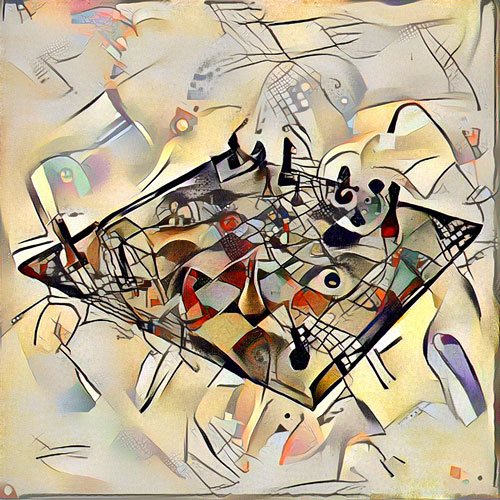
The endgame has its own strategic rules. For instance king and rook vs king is almost always a draw, whereas king and two knights vs the bare king (prepare for this) is a win for Black, but not for White! The reason is that Black always has an even number of moves on his turn, while White’s odd-number oscillations with a bare king make him vulnerable to a checkmate with two knights. There are many such strategical points that have to be learned if you want to become a master.
I played Progressive Chess intermittently for maybe a year, but it was difficult to find opponents. There were a lot of tournaments, but few (actually none) in my area of residence. And so after a while my over-the-board activities in this attractive field of chess ran dry. Luckily I discovered that it is not absolutely necessary to have an opponent sitting across from you to enjoy the variant. There is a whole world of Progressive Chess problems, positions with very clever and very deep solutions, in many cases equal in beauty to my beloved helpmates. And so I continued to delve into this field, solving mates and studies, but very rarely actually playing a game.
Then I learned, quite recently, that a friend, Professor Matej Guid of the University of Ljubljana, had actually written a book on subject, a comprehensive volume with all the information you need to get started (or become an expert). I read it voraciously and spent pleasant hours solving some of the hundreds of problems and studies that he has included. I have also learned that a graduate student at the University of Ljubljana, Vito Janko, has developed a Progress Chess playing program that gives you a strong opponent or training partner, as well as an analytical tool to study games and problems. As chance would have it, part three of this book gives you basic lessons in openings and endgames, just as any normal chess primer helps you get started in the classical version.
I strongly advocate that you peruse this e-book, the first comprehensive work in a non-Italian language; and get the Progressive Chess engine of Vito Janko, which is also available as a mobile app. Then you can give this fascinating chess variant a try. Chances are you will not regret it.

You can download the Progressive Chess player here. It is a 548 KB zip file, which contains a Java file, chessV2.0.jar, which you simply start (i.e. no installation required). The PC-player has the following features:
- playing against the computer,
- playing or analyzing games from any given progressive chess position,
- searching for checkmates,
- loading, saving, and viewing games, etc.
There is also a free Android application available on Google Play. The desktop version is stronger and offers more functionalities; however, the mobile version is "a strong AI player," as one user has testified. And you can use it on trains, planes and in the garden.
Anyway, once you have started the program you can make your first moves, e.g. 1.e4 1...d5 Nc6, 2.exd5 dxc6 Bb5 2...Bg4 Qd3 Qxc2 Qxd1 mate!

Okay, so this is not an easy game, you have to put some thought into it if you want to survive more than a few moves. Let us take a look at a slightly more advanced game, taken from Matej Guid's book
1.e4
2.d5 Nc6
3.e5 d4 Bb5

In this position, Black has four moves at his disposal. His priority is to remove the white queen from the board, and it happened as follows:
4.Bg4 Bxd1 Kd7 Qb8
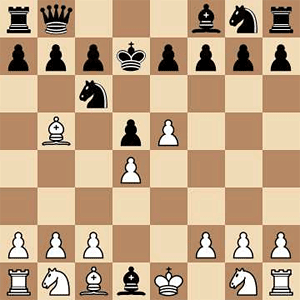
With this sequence, Black has improved the position of his king and moved the queen to a square that is more difficult to reach by any white pieces. But let's see what happened.
5.Na3 Nc4 Na5 Nxc6 Nxb8++
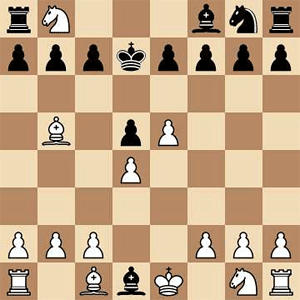
White has captured his opponent’s knight and queen, and is, by also giving a double check to the king, forcing it to lose precious time.
6.Ke6 Rxb8 a6 axb5 Kd7 c5
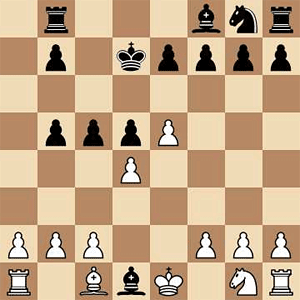
Black has captured two white pieces, secured the king again, and advanced with two of his pawns, bringing them closer to the square of promotion. Now it is White’s turn.
7.a4 axb5 Bh6 Bxg7 Bxh8 Kd2 Rxd1
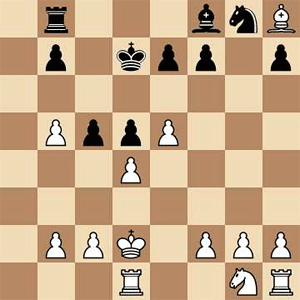
White achieved the following: one of the dangerous black pawns and the black bishop on d1 were captured, also a rook has been removed from the board, and the position of the white king was slightly improved. White is currently a rook and two pawns up, which is also not bad. However his sequence was in fact the decisive mistake! Black now has checkmate in eight moves at his disposal. Can you see the winning sequence?
8.cxd4 Rc8 d3 d4 dxc2 c1N e6 Bb4# 0-1

Black coordinated his pieces in excellent fashion, and played a rather surprising promotion into a knight, in order to deliver checkmate in time. Fascinating play! In fact, this was a blitz game Matej Guid lost to the Progressive Chess computer program. Indeed, the program was very helpful while preparing the materials for Guid's book.
Progressive Chess problems
We turn to the problems – mate in n move, or White/Black wins. These are the most fascinating for me. Here's an instructive example:
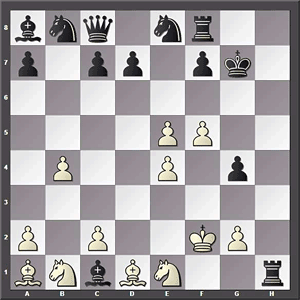
White to play and checkmate in 7 consecutive moves
The solution is 7.Nf3 Nd4 (to shield the black king from check by the bishop on a1, so that the e-pawn can advance) e6 e7 exf8R! Rh8 Ne6 mate. You can retrace the moves on the following diagram:
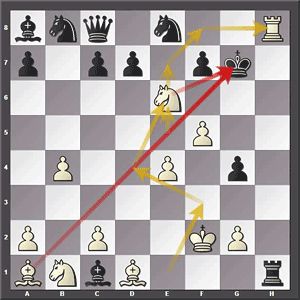
Matej Guid's book contains by my count 240 problems: Checkmate in 4, 5, 6, 7, 8 and 9, the "Italian checkmate", winning and drawing sequences, plust solutions at the end of the book. One type of problem fascinated me: the kind that involves the Italian checkmate.
There are two main variants of Progressive Chess: the Scottish version, which I played in my teens, and the Italian version, which has more games recorded and more research done on it. The main difference is that in Scottish progressive chess a check may be given on any move of a series. It simply ends the series – all further moves that the player would be allowed are forfeited. This has no effect on the other player's next series: he receives as many moves as he would have had if the opponent had played his full series.
In Italian progressive chess a check may only be given on the last move of a full series – at any other point in a series it is illegal. This leads to the following consequence: if the only way for the opponent to escape the check is to himself give check on the first move of the series, then the game is lost by the player in check by "progressive checkmate". Here's an example:
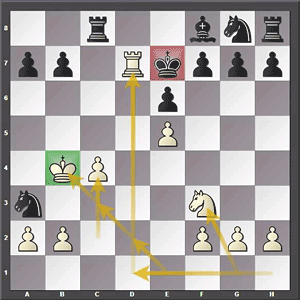
In the above position White played seven moves: 7.Nf3 (to make the path free for the rook) c4 (to allow the king to cross the c-file without exposing itself to a check by the black rook) Kd2 Kc3 Kb4 (an important attacking move) and then Rd1 Rd7 mate. Why can't Black now start his sequence by capturing the unprotected rook with 8.Kxd7? Because that would give check to the white king and is thus illegal. The black king is "pinned"!
Like to try you hand? Here are three examples from the book:

Note that the numbers next to the diagrams denote how many moves there are to play and consequentially whose move it is. For instance 5 indicates that it is White to move (White always plays an odd number of moves) and he can play five moves in succession. 6 indicates that it is Black to play and he has six sequential moves. In all three cases, taken from actual games, the side to move mates – according to the Italian rules! Can you work it out?
Solutions
Note that in ChessBase if you want to input Progressive Chess moves, you can do so by using the null move entry: Ctrl-Alt-0. This allows you to enter a second move of the same colour, and replay everything in the program or on the ChessBase replay boards. Matej Guid sent me a collection of fifteen sample problems in ChessBase format. You can drag the vertical divider fully to the right to view the positions without the answers (in ChessBase or Fritz you can go to menu View and switch Notation off). Then you can try to solve these problems yourself. Qudos if you succeed with five of them.
Progress Chess sample checkmate problems
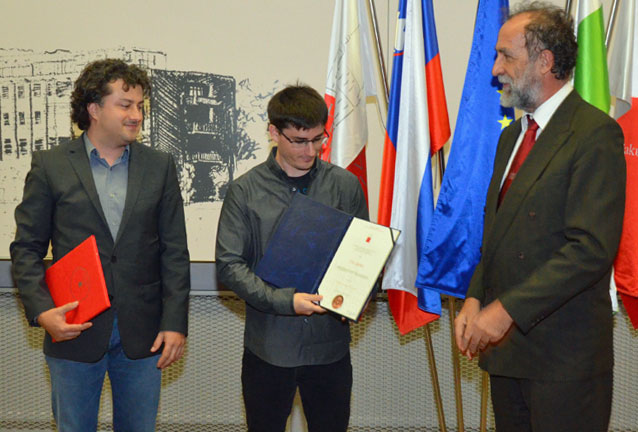
Matej Guid and Vito Janko at the ceremony for Prešeren awards for students at the Faculty of Computer and Information Science with the Dean of the Faculty, Bojan Orel.
Incidentally the graphic chess art works in the book and on this page were created by Matej Guid, using an AI neuro style transfer algorithm, imitating the styles of various artists and merging them with suitable compositions of chess pieces. As you can see: AI is everywhere.
Links
-
Learn and Master Progressive Chess – by Matej Guid
Click to read in your browser; right-click and "save" to store it on your drive. The book is 84 pages long and in the next six months or so it will be extended with instructive commented games – and perhaps also with some A.I. algorithms, e.g. for finding checkmates.
-
The program for playing Progressive Chess – by Vito Janko
You should download the 548 KB zip file, which contains a Java file, chessV2.0.jar, which you simply start (i.e. no installation required). There is also a free Android application available on Google Play. The desktop version is stronger and offers more functionalities; however, the mobile version is a strong AI player, and you can use it on trains, planes and in the garden.
-
PRBASE – Italian Progressive Chess Database by Deumo Polacco (with contributions by Alessandro Castelli and Mario Leoncini). This PGN database contains 2970 master-level games.
 Matej Guid [pronounced Mat-TAY Geed] is an Assistant Professor at the University of Ljubljana, Slovenia, Faculty of Computer and Information Science. He conducted research in various areas of artificial intelligence including heuristic search, computer game-playing, automated explanation and tutoring systems, and argument-based machine learning. In chess, he is well known for his joint work with Ivan Bratko on analysing the quality of play in chess games and computer analysis of World Chess Champions. Chess has been one of his favourite hobbies since childhood: he was a junior champion of Slovenia a couple of times, and holds the title of FIDE master.
Matej Guid [pronounced Mat-TAY Geed] is an Assistant Professor at the University of Ljubljana, Slovenia, Faculty of Computer and Information Science. He conducted research in various areas of artificial intelligence including heuristic search, computer game-playing, automated explanation and tutoring systems, and argument-based machine learning. In chess, he is well known for his joint work with Ivan Bratko on analysing the quality of play in chess games and computer analysis of World Chess Champions. Chess has been one of his favourite hobbies since childhood: he was a junior champion of Slovenia a couple of times, and holds the title of FIDE master.
 Vito Janko is a PhD candidate, working at Jožef Stefan Institute in Ljubljana, Slovenia. He obtained his Master's degree at the University of Ljubljana, finishing the interdisciplinary study of Mathematics and Computer science. His Master's degree focused on building the first AI to successfully play the chess variant "Progressive chess," for which he received Prešeren award for students at the Faculty of Computer and Information Science. His current research focuses on artificial intelligence, both for playing games and for analysing real-life signals.
Vito Janko is a PhD candidate, working at Jožef Stefan Institute in Ljubljana, Slovenia. He obtained his Master's degree at the University of Ljubljana, finishing the interdisciplinary study of Mathematics and Computer science. His Master's degree focused on building the first AI to successfully play the chess variant "Progressive chess," for which he received Prešeren award for students at the Faculty of Computer and Information Science. His current research focuses on artificial intelligence, both for playing games and for analysing real-life signals.


































 Matej Guid [pronounced Mat-TAY Geed] is an Assistant Professor at the University of Ljubljana, Slovenia, Faculty of Computer and Information Science. He conducted research in various areas of artificial intelligence including heuristic search, computer game-playing, automated explanation and tutoring systems, and argument-based machine learning. In chess, he is well known for his joint work with Ivan Bratko on
Matej Guid [pronounced Mat-TAY Geed] is an Assistant Professor at the University of Ljubljana, Slovenia, Faculty of Computer and Information Science. He conducted research in various areas of artificial intelligence including heuristic search, computer game-playing, automated explanation and tutoring systems, and argument-based machine learning. In chess, he is well known for his joint work with Ivan Bratko on  Vito Janko is a PhD candidate, working at Jožef Stefan Institute in Ljubljana, Slovenia. He obtained his Master's degree at the University of Ljubljana, finishing the interdisciplinary study of Mathematics and Computer science. His Master's degree focused on building the first AI to successfully play the chess variant "Progressive chess," for which he received Prešeren award for students at the Faculty of Computer and Information Science. His current research focuses on artificial intelligence, both for playing games and for analysing real-life signals.
Vito Janko is a PhD candidate, working at Jožef Stefan Institute in Ljubljana, Slovenia. He obtained his Master's degree at the University of Ljubljana, finishing the interdisciplinary study of Mathematics and Computer science. His Master's degree focused on building the first AI to successfully play the chess variant "Progressive chess," for which he received Prešeren award for students at the Faculty of Computer and Information Science. His current research focuses on artificial intelligence, both for playing games and for analysing real-life signals.




